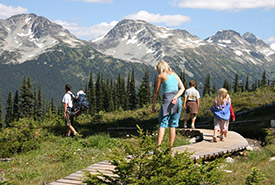What's ahead for NCC in 2017?

Family hiking near the mountains (Photo courtesy ParticipACTION)
Conservation has always been a diplomatic balance between fear and hope. Too much fear, and our actions seem futile. Too much hope, and optimism may blind us.
There is fear over the state of nature in Canada. Loss of habitats and species, climate change, fragmentation and invasive species have become regular stories on our news. But there are also grounds for hope that makes this a truly exciting time to be involved in conservation. The Nature Conservancy of Canada (NCC) is finding new ways to advance nature conservation and the legacy we will leave for future generations.
Conservation on the world stage
There’s no question that nature conservation needs to move more quickly. The next few years are going to be critical for Canada and the world in achieving international commitments to conserve biodiversity, including the protection of 17 per cent of our lands and inlands waters and 10 per cent of our marine and coastal areas by 2020.
NCC will continue to help Canada meet and exceed these targets. We’ll be leveraging our successful Natural Areas Conservation Program partnership with Environment and Climate Change Canada to match private donations, and working to expand corporate partnerships. We are also continuing to explore opportunities that replicate the success of our Lancaster Sound project that will contribute to new marine protected areas in Canada.
Thinking big
NCC’s focus on key natural areas across Canada is showing impressive results, on which we’ll continue to build. This includes better connecting natural habitats, buffering existing parks and protected areas and managing invasive species. The scale of our projects has also been growing, such as Darkwoods in BC, Ontario’s Lake Superior coast and the Kenauk project in Quebec. More of these large, transformative landscape conservation projects are planned for the near future.
NCC’s core work has always been based on identifying and protecting important places for Canada’s species and habitats. Although the goal has remained the same, how we do this work has changed drastically over the last half century. Our scientists now have access to new data on species and habitats, and analytic tools that can help focus in on key sites. In 2016, NCC joined the Conservation Measures Partnership, ensuring we have access to best tools and approaches to conservation and ensuring your investments in nature are being directed to the most important places.
Supporting species conservation
Canada’s fourth report on the general status of species will be released this year, and will provide important information on the status and trends of wildlife. NatureServe Canada will also be launching a report on Canada’s globally rare species in April at an international conference. NCC scientists and land managers are continuing to support the recovery of some of Canada’s most endangered species, such as Blanding’s turtle, piping plover and Sprague’s pipit.
In addition to rare species, NCC is also working to maintain and enhance the richness and abundance of Canada’s wildlife for future generations. Studies are showing that migratory species are often the most vulnerable to decline because of their large ranges. NCC will be putting more emphasis on protecting key stopover sites for migratory birds, and continuing to protect and restore some of North America’s most important wildlife corridors.
The north
Canada’s north is a vast landscape that few Canadians are familiar with. Building on the success of the Newfoundland and Labrador Nature Atlas, NCC will continue to create accessible information on biodiversity and conservation that is readily accessible to local and indigenous communities, governments, and resource managers. We will continue to develop the awareness Canadians have about our boreal and arctic ecosystems, and foster a national pride about the importance of our north for conserving some of the last areas of global wilderness and maintaining areas that help to capture and store vast amounts of carbon.
Connecting to Canadians
We will also be exploring how we can better link our work conservation to people. There is a finally a broader understanding that we need nature for prosperous communities, sustained economic prosperity and healthy children. By showing how our conservation efforts protect drinking water and buffer communities from the impacts of climate change, to working with TD Bank Group to identify the natural capital values of forests, to more interpretive hikes on NCC properties and encouraging people to discover urban biodiversity, these actions will increase the number of Canadians that understand and care about the importance of conservation, and ultimately allow us to protect more.
Embracing hope
While fear may spark conservation action, it ultimately needs to be fueled by hope. The coming years could prove to be some of the most important for conservation, and an opportunity to protect species and habitats at an unprecedented rate. We have the tools to let us achieve our mission, opportunities to match private donations, and a growing portfolio of inspiring examples where conservation is working to the benefit of nature and people. We need to do more conservation, and we need to do it faster. We must embrace this opportunity for hope — this opportunity to advance Canadian conservation and leave a legacy that will echo for generations to come.


